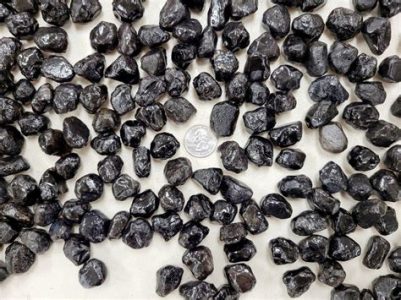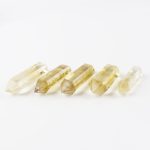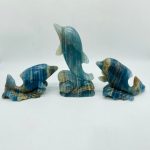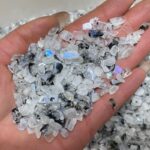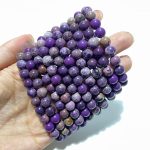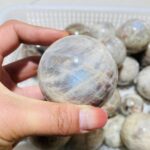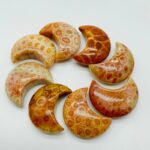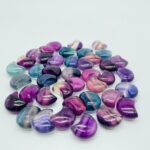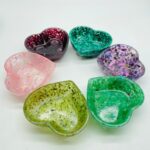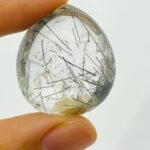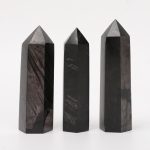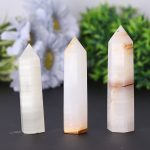Introduction
Green crystals have captivated humans for centuries, symbolizing everything from prosperity to nature’s bounty. Among the most popular green crystals are emerald and peridot, each possessing unique properties and symbolism. This article will explore the differences and similarities between emerald and peridot, examining their history, characteristics, and applications.

Emerald
History and Mythology:
Emerald, a variety of the mineral beryl, has been revered since ancient times. In ancient Egypt, it was associated with the goddess Isis and believed to possess healing powers. Cleopatra, the famous Egyptian queen, was known for her love of emeralds.
Characteristics:
Emeralds are distinguished by their deep green color, which is caused by trace amounts of chromium or vanadium. They are typically transparent to translucent and can exhibit a vitreous to subadamantine luster. Emeralds are relatively hard, with a Mohs scale rating between 7.5 and 8.
Peridot
History and Mythology:
Peridot, also known as olivine, has been used in jewelry for over 2,000 years. It was believed to bring good luck and was often used in talismans and amulets. The ancient Egyptians considered peridot to be a symbol of the sun god Ra.
Characteristics:
Peridot is characterized by its vibrant green to olive-green color, which is caused by the presence of iron. It is translucent to transparent and exhibits a vitreous to resinous luster. Peridot is slightly softer than emerald, with a Mohs scale rating between 6.5 and 7.
Emerald VS Peridot
Color:
Emeralds are typically a deeper, more saturated green than peridots. Emeralds may exhibit a bluish-green hue, while peridots usually have a yellowish-green tint.
Clarity:
Emeralds are often included with visible imperfections, while peridots are generally cleaner and more transparent.
Hardness:
Emeralds are harder than peridots, making them more suitable for everyday wear.
Applications
Jewelry:
Both emeralds and peridots are popular choices for jewelry, particularly in rings, earrings, and necklaces. Emeralds are considered more valuable and prestigious, while peridots are a more affordable option.
Healing:
Emeralds are believed to have numerous healing properties, including strengthening the immune system, reducing stress, and improving eyesight. Peridots are said to promote emotional balance, reduce anxiety, and aid in digestion.
Other Uses:
Emeralds and peridots have also been used in various other applications throughout history, including:
| Application | Emerald | Peridot |
|---|---|---|
| Currency | Ancient Egypt | Ancient Greece |
| Architectural decoration | Ancient India | Renaissance Europe |
| Religious artifacts | Ancient Peru | Roman Empire |
Future Trends
The demand for green crystals, including emeralds and peridots, is projected to increase in the coming years, driven by growing consumer interest in sustainability, wellness, and unique gemstones. Additionally, advancements in mining and processing techniques are expected to make these crystals more accessible and affordable.
Conclusion
Emerald and peridot, two captivating green crystals, offer distinct beauty and symbolism. While emeralds are renowned for their deep green color and prestige, peridots provide a more affordable and versatile option. Both crystals have been prized throughout history and continue to inspire awe and admiration today. As the demand for green crystals grows, it is likely that emeralds and peridots will remain popular choices for jewelry, healing, and other applications.
Tips and Tricks
- When choosing an emerald or peridot, consider the desired color, clarity, and size.
- To care for emeralds and peridots, clean them regularly with warm, soapy water and avoid harsh chemicals or ultrasonic cleaners.
- Store emeralds and peridots in a cool, dark place to prevent fading or discoloration.
Step-by-Step Approach to Identifying Green Crystals
- Examine the color: Green crystals may exhibit various shades of green, from deep emerald to pale peridot.
- Check the clarity: Look for inclusions or imperfections that indicate the natural formation of the crystal.
- Consider the hardness: Use a Mohs scale to determine the hardness of the crystal. Emeralds are typically harder than peridots.
- Consult a professional: If unsure about the identification, seek expert guidance from a gemologist or jeweler.
New Word: “Verdancy”
Verdancy, a word coined to describe the vibrant greenness of emeralds and peridots, captures the essence of their captivating allure. It evokes a sense of freshness, growth, and the abundance of nature.









